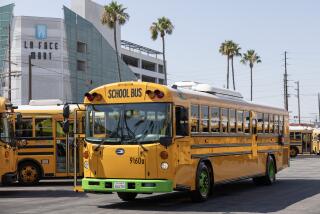Capitol Journal: The L.A. teachers’ strike could be just the beginning for California

Reporting from Sacramento — Stay tuned for sequels. The Los Angeles teachers’ strike looks an awful lot like episode one in a statewide series.
Education officials everywhere are grappling with the same money problems as the Los Angeles Unified School District: unfunded retirement liabilities, competition from charter schools, bulging class sizes and the lack of campus nurses, counselors and librarians.
The money eaters that keep devouring more and more tax dollars are the unfunded liabilities for future pensions and healthcare. Figure $2 available for every $3 promised in benefits.
Charter and private schools are luring students away from traditional public K-12 classrooms, with state money lost on every vacated seat. Sure, that means fewer kids to educate, but it doesn’t necessarily reduce costs. Teachers and buildings still have to be paid and maintained, whether class sizes are 35 or 40 students.
School officials in Oakland and Sacramento also have been sounding the alarm about looming insolvency. Unions have been threatening strikes.
All this makes the six-day L.A. strike seem like a scary harbinger of teacher walkouts to come across the state.
The negotiated contract settlement — phased-in 6% raises for teachers, a tiny dent in class sizes, more nurses, counselors and librarians — will cost the district an additional $400 million-plus over the next four years. Initially the money will come from shrinking reserves, but that eventually will disappear.
It’s as if the district rolled dice, betting that it wouldn’t crap out and more money would show up — from Sacramento, tax increases or both.
Listening to both sides in L.A., you’d think there was easy money-plucking in Sacramento — that there’s a big drawer full of cash and all that’s needed is for Papa Bear to reach in and pull out a fistful.
Well, there’s lots of competition for that money.
Gov. Gavin Newsom and Democratic legislators are eager to expand early education and child care. Yes, maybe they should take care of K-12 first.
They’ve also promised to deliver universal healthcare. And they want to extend Medi-Cal health coverage to immigrants in the U.S. illegally up to age 26. They’re trying to provide shelter for California’s growing homeless population, make urban housing more affordable and greatly improve wildfire prevention.
Maybe the state does underfund its schools, as the districts and unions claim. But if California is going to have the most generous Medicaid healthcare system in the country and a welfare program second to none, there’s going to be less money for other things, like public education.
There’s a projected state surplus of about $21 billion. But Newsom is wisely trying to use that for one-time spending rather than ongoing expenditures such as teachers’ salaries. There’s also $15 billion-plus in a “rainy day” preserve that the governor is stashing for the next recession.
Sacramento is already — and has been for decades — doing a lot for schools, ever since Proposition 13 in 1978 drained most of their local property tax revenue.
About 41% of the state general fund is allotted to K-12 schools. Newsom has proposed giving them nearly $59 billion in the next fiscal year.
Coverage of California politics »
The governor has suggested an extra $2 billion for districts such as L.A. Unified that are heavy with low-income and English-learner students.
Plus, he is asking the Legislature for $3 billion to help K-12 schools and community colleges with their pension costs. Of that, $700 million would be money the schools wouldn’t need to spend on pensions and could use for whatever they wanted.
Unfunded pension and healthcare liabilities are steadily draining school district treasuries. There’s a $107-billion hole between pensions promised and money in the pipeline to pay for them. Trying to catch up, the California State Teachers’ Retirement System has ordered the districts to substantially increase their contributions.
Districts now are kicking in the equivalent of 16% of teachers’ salaries. That will soon rise to 18% and probably hit 20% by 2021. The state is contributing nearly 10% and teachers 10.2%.
L.A. Unified Supt. Austin Beutner told me, “There should have been a strike in the state capital. That’s where the money comes from. This is a Sacramento conversation. It’s time they match their words with deeds.”
But Sacramento doesn’t seem enthusiastic.
“L.A. is not unique,” says state Sen. Holly J. Mitchell (D-Los Angeles), who heads the Senate Budget Committee. “I’m a product of LAUSD. But a number of other districts are in very similar circumstances and are at the brink.
“We need to figure out how to come up with structural solutions, not just a Band-Aid. Where is the money going and what do we need to do differently? What are people willing to pay for?”
Assemblyman Kevin McCarty (D-Sacramento), chairman of the Budget Subcommittee on Education Finance, says: “We need to be putting more money into schools. We’re shortchanging our teachers. But districts have to be responsible and look at their revenue. Realize how much is coming in and budget how much they can afford to send out.”
Schools are hoping for tax hikes.
In 2012 and 2016, voters stepped up for schools with hefty income tax increases, although not on them. They hit the rich hard.
For 2020, an initiative has qualified for the ballot to alter sacrosanct Proposition 13 by taxing commercial property at its market value. That’ll be a tough sled.
There’s also talk of a proposed parcel tax in L.A. That would require a two-thirds majority vote. It’s a high hurdle. But if L.A. wants a solvent district — let alone better schools — taxing itself is probably the best answer.
This could become a horror series.
Follow @LATimesSkelton on Twitter
More to Read
Get the L.A. Times Politics newsletter
Deeply reported insights into legislation, politics and policy from Sacramento, Washington and beyond. In your inbox three times per week.
You may occasionally receive promotional content from the Los Angeles Times.









